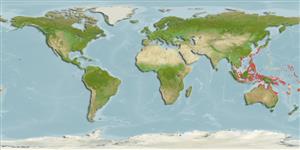Preferred temperature (Ref.
123201): 24.7 - 29.2, mean 28.6 °C (based on 1444 cells).
Phylogenetic diversity index (Ref.
82804): PD
50 = 0.5000 [Uniqueness, from 0.5 = low to 2.0 = high].
Bayesian length-weight: a=0.00562 (0.00258 - 0.01228), b=3.06 (2.87 - 3.25), in cm total length, based on LWR estimates for this (Sub)family-body shape (Ref.
93245).
Trophic level (Ref.
69278): 2.6 ±0.1 se; based on size and trophs of closest relatives
Widerstandsfähigkeit (Ref.
120179): hoch, Verdopplung der Population dauert weniger als 15 Monate. (Preliminary K or Fecundity.).
Fishing Vulnerability (Ref.
59153): Low vulnerability (10 of 100).
Nutrients (Ref.
124155): Calcium = 196 [94, 333] mg/100g; Iron = 0.901 [0.498, 1.558] mg/100g; Protein = 18.3 [17.0, 19.4] %; Omega3 = 0.0809 [, ] g/100g; Selenium = 16.4 [7.3, 36.8] μg/100g; VitaminA = 139 [40, 476] μg/100g; Zinc = 2.51 [1.62, 3.70] mg/100g (wet weight);
